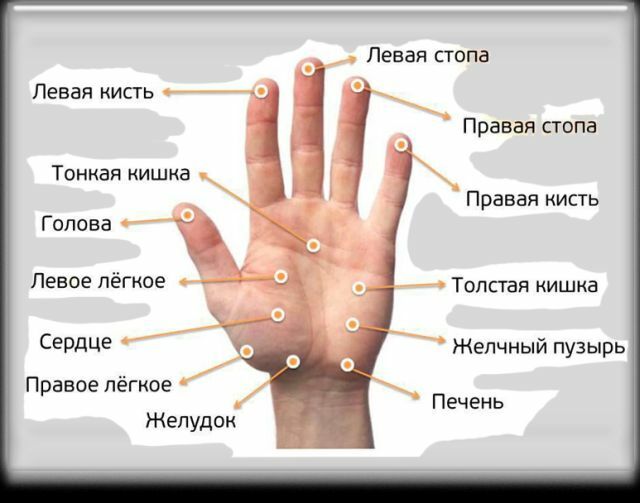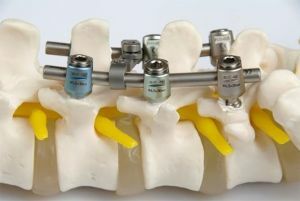 Transpedicular fixation( TPF) is a method of repairing damaged segments of the spine with special titanium screws.
Transpedicular fixation( TPF) is a method of repairing damaged segments of the spine with special titanium screws.
This procedure, considered a complex surgical intervention, allows you to reliably fix the spine for its recovery from injury, reduce the load. It should be noted that the DFT method is quite young, it is constantly being modernized taking into account the experience of the past.
The method itself represents the installation of titanium screws in the vertebra through the pedicle( pedicula).The screws are connected with each other by special fasteners. Thus, a reliable fixation of the site of the spine is performed, in which the patient can recover from injury. Sometimes a bone graft is used.
In the late 1990s, transpedicular fixation of the spine was considered a very complicated operation, even with a good result, the patient needed a long rehabilitation after the intervention. Frequent complications were blood loss, suppuration. The operations lasted a very long time and required great work and professionalism.
Currently, computer assisted tomography, x-ray methods, has come to the aid of surgeons, which made it possible to carry out operations without heavy consequences in a minimally invasive way.
The latest developments allow the use of radical therapy for children aged 3 years.
The essence of transpedicular fixation is that a screw with a titanium coating is screwed into the body of the vertebra. The patient is placed on the abdomen, a roller is placed beneath the thorax - so the spine is located in a physiological position.
Screw is screwed to a depth of 80% of its length. At the same time, the surgeon monitors the process with the help of equipment. It is important not to damage the vessels, nerve roots and spinal cord. The transverse stabilizer is installed at the end of the screw system.
If you plan to fix a large area, then the screws are strengthened by all the vertebrae. This eliminates the possibility of overloading and, as a result, a breakdown of the materials used.
Contents of the article
- Indications for interventions
- Preoperative preparation of
- Mechanisms and devices used in operation
- Advantages and risks
- Rehabilitation after operation
- Restrictions and contraindications
- Opinion of "affected"
- Price range
Indications for intervention
This method was widely used intraumatology with a fracture of the spine. Since this intervention excludes the displacement of vertebral disks, it is also used in other cases. Reliable fixation of the spine is necessary in such cases:
- spondylolisthesis;
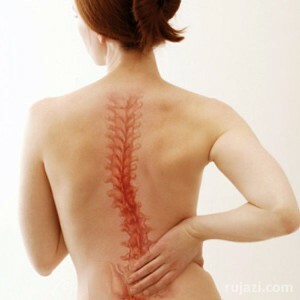
- spine injury;
- narrowing of the spinal canal( stenosis);
- fracture is compression and traumatic;
- fractured;
- hyperdynamics of the ridge and its instability;
- degenerative changes;
- scoliosis of the 3rd stage, kyphosis;
- false joint( pseudoarthrosis);
- destruction of disks.
For cancers with spine injury, transpedicular fixation is sometimes prescribed. The procedure is performed in small areas of the thoracic or lumbar regions.
Preoperative preparation
All standard laboratory tests and preoperative surgical procedures are planned before planning a surgical intervention.
The surgeon then carefully examines the spine, taking into account all the individual characteristics. This is necessary in order to correctly choose the dimensions: the diameter and length of the screws.
 If you plan to fix several vertebrae, make a wire frame and use it as a template. It also determines the necessary parameters of the screws.
If you plan to fix several vertebrae, make a wire frame and use it as a template. It also determines the necessary parameters of the screws.
Usually during the operation fix 1-2 segments, using for this 4 to 6 screws.
With successful transpedicular fixation, after a few days the patient is allowed to get up and within a month the person can return to normal life. With positive dynamics after 12 months, the fusion of damaged bones occurs.
Mechanisms and devices used in operation
The transpedicular screw system consists of flat titanium screws and taps in the form of a double helix. The texture of the fastening material is multilayered. For screws, the upper caps are provided, which protect against screwing and misalignment. The screws are fastened together by springing metal elements.
The transpedicular construction manufactured in the Republic of Belarus is most often used.
The screw can be:
- monoaxial;
- is oliaxial;
- with lateral fixation of the rod.
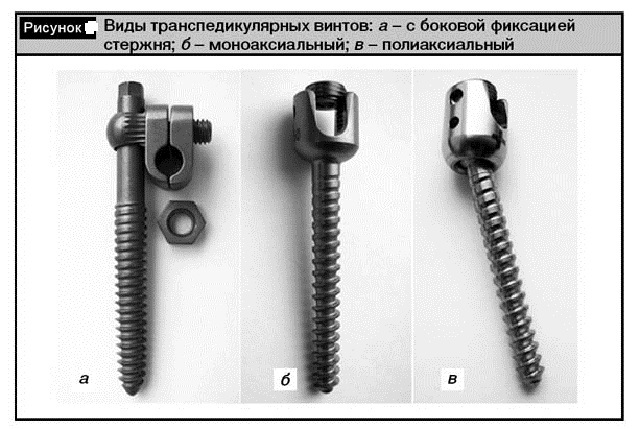
The entire intervention process is monitored using X-ray equipment and computed tomography.
Advantages and Risks of
The advantages of rdspedicular stabilization of the spine include the reliability of fixation, a small incision( 2-2.5 cm), a high percentage of positive results, a relatively short rehabilitation period after surgery. A significant plus of the method is that it relieves the patient of the pain syndrome in a short time. 
The disadvantages of the method are complications. They can arise from errors in the planning of the intervention and during the operation itself. To avoid this, you should carefully consider the choice of surgeon.
The risks involved in the operation are as follows:
- the possibility of damage to the nerve root, vessel, or spinal cord due to improper connection and perforation of the vertebrae;
- inflammation of the sites of the screw joint and subsequent suppuration;
- crash rod.
Modern methods of diagnostics and operation allow avoiding errors and greatly simplify the procedure.
Rehabilitation after surgery
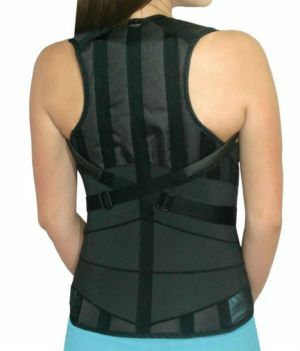 Rehabilitation in a hospital will be from 5 to 7 days. Already on the first day after the operation, the patient can move.
Rehabilitation in a hospital will be from 5 to 7 days. Already on the first day after the operation, the patient can move.
After the second day, the patient is allowed to get up. In some difficult situations, bed rest can last up to five days.
Rehabilitation at home lasts for a month. The patient should wear a special corset for several months.
30 days after DFT, the patient returns to his usual life. Special recommendations will be given by the doctor who performed the operation. Usually, it is important to conduct therapeutic gymnastics for complete recovery.
In the period from 6 to 12 months, the bones of the spine grow together.
Limitations and contraindications
Contraindications for transpedicular fixation are very conditional, and in each individual case, the individual approach is the most important.
Contraindications include:
- pregnancy;
- obesity;
- bone loss caused by severe degree of osteoporosis;
- damage to the upper parts of the thoracic spine( due to the small size of the damaged area there is no possibility to install a screw system);
- infectious diseases, especially in the planned intervention segments;
- individual intolerance( rejection of foreign components).
In itself, individual intolerance is not an allergy. But there are patients whose body does not accept foreign bodies.
Opinion of the "affected"
Numerous positive testimonies indicate that transpedicular fixation of the spine at this stage of the development of medicine is tolerated by patients well and does not cause subsequent complications.
A compression fracture in the lumbar region was caused by a car accident. Very worried, I was afraid that I could not walk anymore. Doctors suggested TPF.Agreed, every chance was important. Surprisingly, after a few days the back pain was completely gone. Quickly went on the mend and returned to work, and to the usual life. I am very grateful to the doctors, and I do not regret that I agreed to the operation.
Marina, 35 years old
I've been involved in sports all my life, I got a serious spinal injury. Doctors advised transpedicular fixation, for which I am grateful. Everything went as I was explained and I quickly returned to active life.
Sports banned, but most importantly, I can move freely. And the trauma does not look like yourself.
Egor, 50 years old
I was diagnosed with a disc displacement. As a child, I suffered a fracture of the spine, which affected later.
Proposed a transpedicular fixation. I did not dare for a long time, after all, it was an operation. But the constant pain and limited mobility forced to go to the operating table. Now I regret that for a long time I doubted and suffered the pain, two weeks after the operation the pain was gone. And if it were not for the corset, I would have forgotten that I had a serious operation.
Sergey, 36 years
Price range
Prices for transpedicular fixation range from 16 to 230 thousand in Moscow. A good result and an acceptable cost in the GVCG them. Academician N. N. Burdenko, here the operation will cost about 16 thousand rubles. 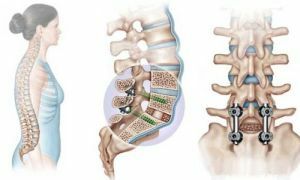
European medical centers offer an operation for 230 thousand rubles or more. Several family clinics offer a procedure for 65 thousand rubles.
Such a spread in prices is due to subsidizing the medical facility, the conditions of sickness and other economic aspects. It should be noted that there are many clinics in which the cost of the operation is available for many social strata of the population.
Conducting the TPF under modern conditions provides a positive prognosis for spinal injuries. The cost of the procedure makes the operation accessible. And short terms of rehabilitation return the patient to a full life 30 days after the operation.



